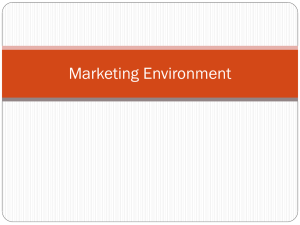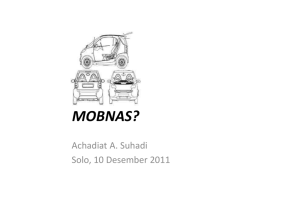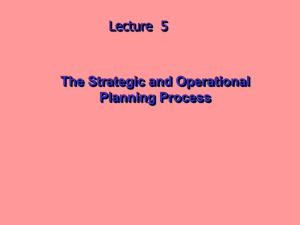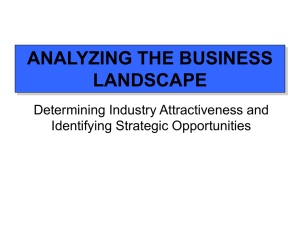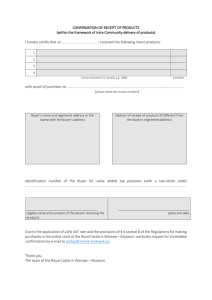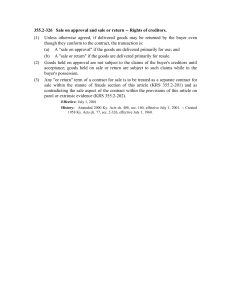Power Point Slides
advertisement
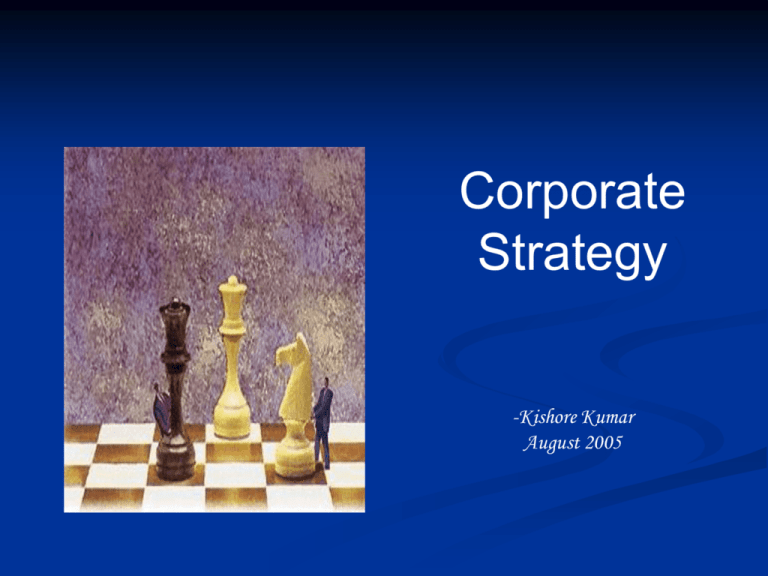
Corporate Strategy -Kishore Kumar August 2005 Characteristics of Strategic Decisions Concerned with the scope of an organization’s activities Matching the organization’s activities to its environment Matching the organization’s activities to its resource capability Strategic decisions have major resource implications Affect operational decisions Influenced by values and expectations of shareholders Determine long-term direction of an organization Levels of Strategy Corporate Level Competitive or Business Strategy Operational Strategy Corporate strategy... defines the scope of the business in terms of the industries and markets in which it competes. includes decisions about diversification, vertical integration, acquisitions, new ventures, divestments, allocation of scarce resources between business units Business strategy... is concerned with how the firm competes within a particular industry or market... to win a business unit must adopt a strategy that establishes a competitive advantage over its rivals. Functional strategy... the detailed deployment of resources at the operational level Vocabulary of Strategy Mission Goals Objective Strategy Tactics Action Control Rewards Characteristics of Strategic Decisions Concerned with the scope of an organization’s activities Matching the organization’s activities to its environment Matching the organization’s activities to its resource capability Strategic decisions have major resource implications Affect operational decisions Influenced by values and expectations of shareholders Determine long-term direction of an organization Strategic Management Strategic Analysis Strategic Choice Strategy Implementation Elements of Strategic Management Strategic Analysis The Environment Culture and Stakeholder Expectations Resources and Strategic Capability Strategic Choice Identifying Strategic Options Evaluating Options Selecting Strategy Strategy Implementation Planning and Allocating Resources Organization Structure and Design Managing Strategic Change Patterns of Strategy Development Natural selection view Planning view Logical incremental view Cultural view Political view Visionary view Integrating views of strategy development Cultural Web Paradigm Stories Symbols Power Structure Organizational structures Control systems Rituals and routines Strategic Drift Analyzing the Environment Macro Environmental Analysis PESTLE Political Economics Social Technological Legal Environmental Michael Porter’s 5 Forces Analysis Porter’s Five Forces Analysis Threat of New Entry Bargaining Power of Suppliers • Differentiation of inputs • Switching costs • Presence of substitute inputs • Supplier concentration • Importance of volume to supplier • Cost relative to total purchases • Impact of inputs on cost or differentiation • Threat of forward integration • Economies of scale • Proprietary product differences • Brand identity • Switching costs • • • • • Capital requirements Access to distribution Absolute cost advantages Government policy Expected retaliation Rivalry Among Existing Competitors • Industry growth • Fixed costs / value added • Overcapacity • Product differences • Brand identity • • • • • • Switching costs Concentration and balance Informational complexity Diversity of competitors Corporate stakes Exit barriers Threat of Substitutes • Relative price performance of substitutes • Switching costs • Buyer propensity to substitute Bargaining Power of Customers • • • • • • • • • • • Buyer concentration Buyer volume Buyer switching costs Buyer information Ability to integrate backward Substitute products Price / total purchases Product differences Brand identity Impact of quality / performance Buyer profits High Low Annual real rate of market growth % Group Analysis Matrix BCGStrategic Growth-Share Earnings: high stable, growing Earnings: Cash flow: neutral Cash flow: negative Strategy: invest for growth Strategy: Earnings: high stable Earnings: low, unstable Cash flow: high stable Cash flow: neutral or negative Strategy: milk Strategy: divest High low, unstable, growing analyze to determine whether business can be grown into a star, or will degenerate into a dog Relative Market Share Low Strategic Capability Resource Audit Physical resources Human resources Financial Intangibles Value-Chain Analysis Comparative Analysis Historical analysis Comparison with Industry norms Best practice analysis Balance of Resources Portfolio analysis Balance of skills/personalities Financial resources Flexibility of resources Key Issues SWOT analysis Strength Weakness Opportunities Threat Core Competency Who owns the competency How durable are the competences How transferable are the competences How replicable are the competences Culture and Stakeholder Expectations Cultural Context – External and Internal Influence Expectations – Individuals, External stakeholders, Internal stakeholders Power Purposes – Mission, Objectives Influence Strategies Cultural Context of Strategy External influences Values of Society Organized groups Internal influences Paradigm Stakeholder Analysis Power – hierarchy, influence, control of strategic resources, knowledge or skills, control of environment, decision-making expertise Dynamism Interest Strategic Choice Development Strategies What Basis – Generic Strategies: price based, differentiation, focus Which Direction – Alternative Directions: withdrawal, consolidation, market penetration, product development, market development, diversification (related or unrelated) How - Alternative Methods: internal development, acquisition, joint development alliances Strategic Evaluation Evaluation Criteria Suitability Feasibility Acceptability Also check portfolio analysis, PLC, Value-chain and profitability Strategy Implementation Resource Allocation identifying resources fit with existing resources – new requirements, changing old…consistency and linkages Organization Structure and Design Simple structure Functional structure Multidivisional structure Matrix Strategic Change Understanding processes of strategic change Diagnosing strategic change needs Managing the strategic change process Styles of managing change Changing organizational routines Symbolic activity Political activity Leadership and change agency

